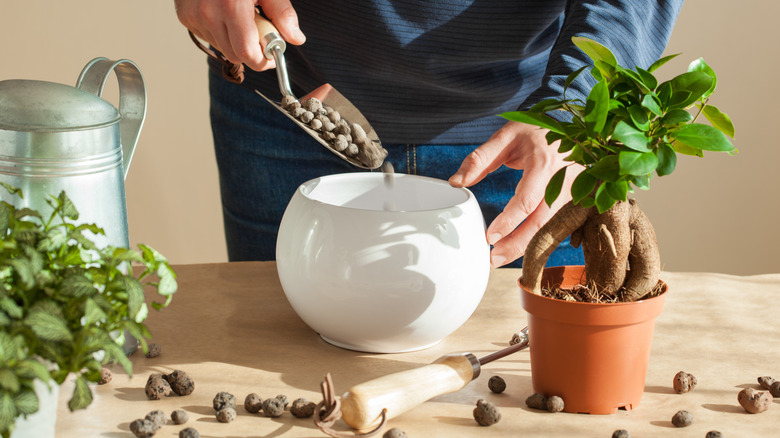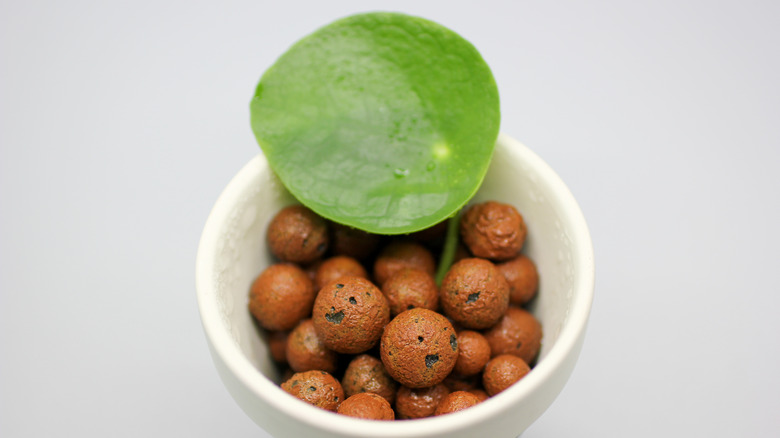The Unexpected Potting Soil Replacement That Houseplant Enthusiasts Are Loving
Houseplants are the new pets as millennials and other generations alike have dived deep into collecting, propagating, and decorating with rare and tropical plants. As with any trend, experimentation and modification have taken hold in the houseplant domain, especially with hydroponics. Lately, LECA, or Lightweight Expanded Clay Aggregate, has appeared across the socials as a potting soil replacement. Composed of small, porous clay pellets that are expanded through high-temperature heating, LECA has been widely used in hydroponics and gardening due to its excellent water retention and aeration properties.
LECA offers a distinct aesthetic appeal compared to traditional potting soil due to its clean and modern look. The uniform, round pellets create a minimalist backdrop that complements any plant's natural form. This contrast enhances the visual impact of the foliage and allows for creative arrangements. Additionally, the absence of messy soil and the ability to showcase roots through transparent containers add to a sophisticated and contemporary presentation, making LECA a favored choice among those who appreciate a sleek and tidy indoor plant display.
Potting your plants in LECA
Choose a plant that is well-suited for LECA, one with adaptable root systems and a preference for well-draining conditions. Opt for a clear or translucent container with drainage holes at the bottom. Thoroughly rinse the LECA pellets to remove dust and debris and prevent cloudiness in the water reservoir. Place a layer of LECA at the bottom of the container. The depth depends on the plant's size, but a few inches is a good starting point. Gently remove the plant from its nursery pot and shake off excess soil. Position the plant's root system on top of the LECA layer. Carefully add more LECA around the roots, ensuring they are well-supported and stabilized. Gently press the pellets to hold the plant in place. If needed, use small stakes or supports to keep the plant steady as the roots establish themselves in the LECA.
Fill the container with water until the level reaches just below the surface of the LECA, creating a reservoir for the roots. Regularly check the water level and top up as needed. Avoid overfilling to prevent root rot. Since LECA lacks nutrients, supplement the plant's needs by adding hydroponic nutrient solution to the water. Observe your plant closely to ensure it's adapting well, and adjust watering and nutrient frequency based on its response. As the plant grows, prune roots that extend excessively or become unhealthy. Periodically replace the nutrient solution and rinse the LECA to prevent buildup.
Benefits of replacing potting soil with LECA
Potting plants in LECA offers distinct advantages over traditional potting soil, primarily centered around optimal root health and precise care control. LECA's porous structure promotes excellent aeration and drainage, preventing issues like root rot caused by waterlogged soil. This enhanced airflow encourages more robust root growth and minimizes the risk of overwatering, providing an environment where plants are less susceptible to fungal diseases and other moisture-related issues. The lightweight nature of LECA also makes it easier to manage larger plants without the added weight of soil, making transplanting and maintenance less physically demanding.
Moreover, LECA provides precise control over nutrient delivery. Unlike potting soil, which may retain excess nutrients or deteriorate over time, LECA's inert nature ensures a clean and stable environment. By incorporating a hydroponic nutrient solution into the water reservoir, plant enthusiasts can finely tune the plant's nutrient intake, promoting optimal growth and health. The absence of soil in LECA reduces the risk of attracting pests, making it a cleaner option for indoor environments. Additionally, the transparent or semi-transparent containers commonly used with LECA allow enthusiasts to observe root health and growth, adding a unique visual element to the gardening experience. That all being said, while some plants thrive in LECA, it may not be suitable for all species, making careful plant selection and research essential to their survival.

